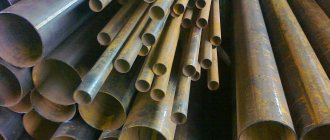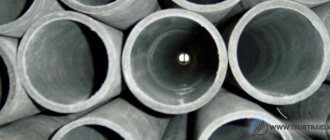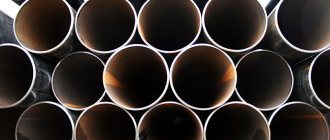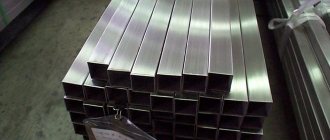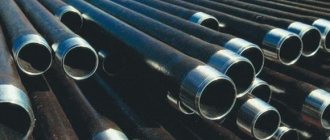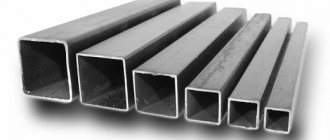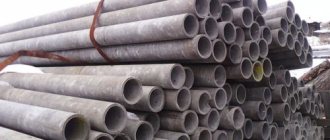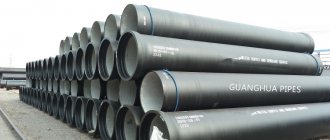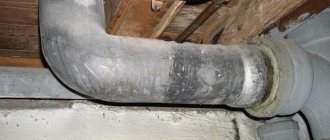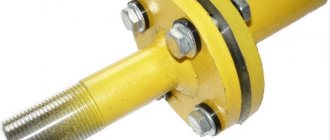A plug is a pipeline part with which the end holes of pipes are closed; its main role is used in the manufacture of various containers: boilers, apparatus, vessels.
Depending on the type, the fitting is installed in systems to completely or temporarily stop the movement of transported products. The pipe part allows you to preserve the pipe section for a long period or carry out periodic maintenance and repair work. It is also used when transporting pipes to avoid internal damage.
Operation of steel plugs is possible:
- at industrial enterprises;
- in public utilities;
- at home.
Types of stubs [edit | edit code ]
Depending on the method of fixation, pipe plugs are divided into flanged, wafer, flat welded, rotary, elliptical, spherical and others.
Flange steel plugs withstand temperatures of the working environment from −70 to + 600 °C. Flange plugs are highly resistant to aggressive media. Such pipe plugs are used for oil and gas and chemical pipelines.
In pipelines with a less wide temperature range of the operating medium, flat welding plugs and elliptical pipe plugs are used.
For each plug, the nominal pressure and nominal diameter must be determined.
Technical documentation
Industrial methods for manufacturing flange plugs, their design options, geometric dimensions and other technical characteristics are regulated by industry state standards. Basic technical information is presented in industry standards ATK 24.200.02-90 and GOST 12836-67. A short list of technical characteristics of blind flanges in accordance with the specified documents includes: nominal and working pressure (from 0.6 to 16 MPa); nominal diameter (from 10 to 1600 mm); operating temperature (from minus 70 to 600°C); material used (steel grade).
Additional industry documentation specifies:
- technical requirements and characteristics for steel flange plugs (OST 26-11-07-85);
- technical characteristics of plugs version 1 (OST 34-10-428-90);
- requirements for rotary plugs (T-MM-25-2000, T-MM-25-01-06, ATK 26-18-5-93);
- working and conditional pressures (GOST 356);
- connecting diameters (GOST 12815);
- requirements for materials (OST 26-291);
- technical requirements for fastening elements of blind flanges (OST 26-2043);
- liver of foreign industry documentation: EN 1092-1, DIN 2527 (Europe), ANSI/ASME B16.5, ANSI/ASME B16.47, API 6 A (USA).
Other uses [ edit | edit code ]
To keep pipes clean during transportation.
Buy cheaper! Discounts and promotions in our newsletter!
A pipe plug is a multifunctional device that plays a decorative role or serves as an important technical element of pipeline systems. This review will help you understand the features of plugs, the possibilities of their use and installation rules.
What types of pipe plugs are there?
In just a short time, the range of pipe plugs has increased many times over. Today you can choose products of various shapes and colors to solve any problem, including the decorative design of open pipelines.
Pipe plugs can be classified according to different parameters:
1. In appearance:
round plugs;
oval-shaped plugs;
with a cross-section in the form of a square;
2. By size
(to buy plugs, you need to know not only the length/width/section, but also the parameters of the pipe wall):
plugs for profile pipes (square) are available in several standard sizes (1.5x1.5cm; 2x2cm; 2.5x2.5cm; 3x3cm; 4x4cm; 5x5cm; 6x6cm; 8x8cm; 10x10cm);
rectangular pipe plugs (1.5x3cm; 2x3cm; 2x3.5cm; 2x4cm; 2x6cm; 2.5x4cm; 2.5x5cm; 3x5cm; 4x6cm; 4x8cm);
round plugs are available in standard sizes (Ø2.5cm, Ø4cm, Ø5.7cm, Ø7.6cm);
For pipe products, you can also buy plugs for profile pipes with non-standard parameters.
3. According to design characteristics:
threaded
products are the most popular option for pipe plugs. They are used for installation of water and gas systems. They are made from high quality steel. The catalogs present products with external and internal threaded connections up to 2 inches in size. When installing a threaded plug, special sealants are used (linen thread, FUM tape, etc.). Fastening the covers to various sealants is undesirable, as this will greatly complicate their dismantling if necessary;
flanged
plugs are used for pipe products with a diameter of more than 2 inches. They are a cover that is attached to the pipe with a bolt. Products made of rubber or paronite are used as gaskets (for pipelines with high ambient temperatures);
spherical
plugs are installed in pipelines with special operational characteristics (oil pipelines, gas mains); Standards for spherical plugs for steel pipes are regulated by GOST 17379-2001. They are able to withstand pressure in the system up to one hundred atmospheres;
pneumatic
plugs are used during emergency procedures. Such a plug on a water pipe allows you to cut off the emergency section in the shortest possible time. It is made of rubber, and it has a special cavity for pumping air. A technological hole is made in the damaged section of the pipeline, a pneumatic plug is installed in it, which is filled with air, which leads to reliable closure of the pipe cavity.
4. According to the installation method, plugs are divided into two types:
internal pipe plugs.
Fixation of such products occurs due to ribbed notches. When installing the plug into the socket, they bend and hold it tightly inside. The top end of the pipe at the installation site is closed with a plug cap;
external plugs
perform several functions: they give the pipes a beautiful shape, serve as a support for them and protect them from the ingress of foreign substances. The main purpose of the plugs is to close the end of the pipe, which prevents moisture and debris from penetrating into it. The shape of the plugs can be rectangular, square, or round, which creates conditions for their use as a decorative element.
In addition, the following types of plugs are distinguished:
transportation
prevent damage to pipes during transportation. Made mainly from plastic;
end
designed to prevent blockages or to block an unused part of the pipeline;
plugs for double-walled pipes.
They are used as external ones to protect the end part of straight, flexible and drainage corrugated pipes from dirt, moisture and foreign objects entering the pipeline branches. They are used during transportation, storage and during repair and construction work.
Short circuit plug cap
Table 1.1
| Type | Type of climate control | d | Dimensions, mm | Weight no more than, kg | ||
| D | L | S | ||||
| Short circuit - G1/2 | U3 | G1/2 - B | 31,2 | 21 | 27 | 0,08 |
| Short circuit - G3/4 | G3/4 - B | 36,9 | 26 | 32 | 0,11 | |
| Short circuit - G1 | G1 - B | 47,3 | 29 | 41 | 0,16 | |
| Short circuit - G11/4 | G11/4 - B | 63,5 | 35 | 55 | 0,41 | |
| Short circuit - G11/2 | G11/2 - B | 69,3 | 40 | 60 | 0,72 | |
| Short circuit - G2 | G2 - B | 86,5 | 50 | 75 | 1,03 | |
(Changed edition,
Amendment No. 2 )
Table 1.2
| Type | Type of climate control | OKP code |
| Short circuit - G1/2 | U3 | 42 1891 0480 |
| T2 | 42 1891 0483 | |
| T3 | 42 1891 0482 | |
| Short circuit - G3/4 | U3 | 42 1891 0484 |
| T2 | 42 1891 0487 | |
| T3 | 42 1891 0486 | |
| Short circuit - G1 | U3 | 42 1891 0488 |
| T2 | 42 1891 0491 | |
| T3 | 42 1891 0490 | |
| Short circuit - G11/4 | U3 | 42 1891 0492 |
| T2 | 42 1891 0495 | |
| T3 | 42 1891 0494 | |
| Short circuit - G11/2 | U3 | 42 1891 0496 |
| T2 | 42 1891 0499 | |
| T3 | 42 1891 0498 | |
| Short circuit - G2 | U3 | 42 1891 0500 |
| T2 | 42 1891 0503 | |
| T3 | 42 1891 0502 |
(Changed edition,
Amendment No. 2 )
What materials are pipe plugs made of?
Plastic pipe plugs
used for sewerage and water supply networks. By protecting the internal cavity of the open end of the pipe from moisture and debris, they prevent many problems from occurring and extend the service life of pipelines.
Read also: How is surface roughness measured?
In general, the main task of plugs is to seal the hole at the end of the pipe. Of course, instead of using a plug, you can weld the pipeline or remove an unused section, but this method will be more labor-intensive and costly. Plastic plugs perfectly seal the end of the pipe. Such products are used in systems for various purposes that are operated at low temperatures.
When installing additional plumbing or removing blockages, a plug for HDPE pipes (pipes made of low-density polyethylene) is the most effective solution. If there is no pressure in the piping system, it can be used as a service hatch. For this purpose, the riser is equipped with special plugs, which provide access to the inside of the pipe to clean it from contaminants. Most often, a polyethylene plug is installed for pipes.
Metal plugs for round pipes
have the same properties as plastic ones. Steel products can be mounted on all types of pipe products. The cross-section of metal plugs ranges from 3.2 to 102 cm. Due to their strength and reliability, they can withstand pressure surges and can be used in systems with high ambient temperatures.
Metal pipe plugs are available in the form of an ellipse, plate or flange. Ellipse-shaped products are made from stainless steel. They are used for pipeline systems in the pharmaceutical, chemical and food industries, since the steel is able to withstand the effects of aggressive environments.
The flange plug has the same properties and can therefore be used in similar areas. Flat plugs can also be installed in the pipeline system, provided that during operation the coolant temperature does not exceed 80 degrees. Products on sale are available in diameters from 5.7 to 102 cm.
For the manufacture of plugs, stainless steel or alloy steel is used. In some cases, high-strength low-alloy steel is used.
Metal plugs for round pipes have some advantages:
resistance to high pressure, temperature changes and aggressive environments;
guarantee of connection reliability under difficult operating conditions;
the ability to carry out dismantling work, regardless of weather conditions.
Chromed metal.
This type of plugs belongs to the expensive segment of products, since they do not corrode and can serve as a decorative element. A chrome-plated metal plug is often used on intake pipes.
Rubber plugs for pipes
serve as protection against debris. They are not suitable as a locking element due to technical characteristics (the plasticity of the material does not allow them to be firmly attached and retain the coolant).
1.3. Characteristics
1.3.1. The plugs must ensure density and strength at the following pressure:
1) plug caps KZ - Ru 16 MPa (160 kgf/cm ), t
from minus 20°С to plus 120°С;
2) plugs P - Ru 25 MPa (250 kgf/cm2), t
from minus 20°С to plus 450°С;
3) plugs PC - Ru 16 MPa (160 kgf/cm2), t
from minus 20°С to plus 120°С.
(Changed edition, Amendment No. 1)
1.3.2. The thread must be clean, without burrs, torn or crumpled threads and signs of corrosion.
1.3.3. The surfaces of the plugs must be clean and free from nicks, burrs, cracks, signs of delamination, shells, and signs of corrosion.
1.3.4. The roughness of the processed surfaces of the plugs must comply with GOST 2789-73 and the instructions on the working drawings.
1.3.5. Anti-corrosion coatings must be carried out in accordance with the table and GOST 9.301-86.
| Name | Type of coverage | |
| Climatic version UZ | Climatic version U3, T3, T2 | |
| Short circuit plug cap | Chem.Ox.prm. | Ts15.hr. |
| Plugs P, PC | Ts6.hr. | Ts15.hr. |
(Changed edition, Amendment No. 2)
1.3.6. Material consumption:
no more stubs;
no more traffic jams.
1.3.7. Average service life is 10 years.
What to consider when choosing a pipe plug
To choose and buy pipe plugs correctly, you should take into account many factors:
1. In the first place when selecting, there is a specific feature of the pipe operation:
A plug for a gas pipe is an element on the quality of which the reliability and safety of the gas pipeline may depend. Elliptical-shaped plugs fall into this category. Threaded connections allow leakage even with minimal clearance;
In heating and hot water supply, metal plugs are used. Plugs made from other materials may change their shape and lose strength when heated. The most reliable high-quality pipe plugs are made from metal (plastic and metal-plastic products are suitable for systems with cold water or for systems with low-temperature coolant);
For water supply installations, products in the shape of an ellipse or flange plugs, as well as plugs with a threaded connection, are used. The main requirement for installing these fittings is correct installation.
2. The next stage of choosing a plug is the tasks that the product must solve:
for temporary cutting off of coolant, fittings in the form of a flange and pneumatic plug are more suitable;
for long-term overlapping of systems, metal products with threads or in the form of an ellipse are used;
Decorative pipe plugs are purchased based on aesthetic preferences.
3. When choosing plugs, do not forget to take into account the material from which the pipe itself is made:
a durable metal product is usually used as a plug for a cast iron pipe;
For plastic pipes, plugs made of the same material are used.
4. Pipe parameters are another important factor influencing the choice of plugs:
plugs for round pipes;
plugs for square pipe;
for pipes with a different cross-section, square-shaped products are used only as a decorative element;
For each pipe, the plug is selected taking into account its parameters.
Production methods
One of the main technological methods for producing plugs is the stamping method (hot, cold). This is a high-performance process that allows us to obtain high-quality blank parts of various shapes and sizes, which are modified to specified dimensions and surface smoothness using cutting methods (plasma, gas). This method allows you to minimize the appearance of voids, shrinkage cavities and other defects. In addition, parts obtained by this method are characterized by good strength characteristics and reliably ensure the tightness of the pipeline over a long period of use.
The second method of producing plugs is the TSESHL method (centrifugal electroslag casting), which also allows you to obtain a high-quality product. The disadvantages of products produced by the TsSEL method are the chemical and structural heterogeneity of the product over the volume of the casting, the possible presence of pores, air pockets, impurities in the composition of the material, etc.
When flanges are put into operation, multi-level quality control of the product is carried out, including: measuring geometric dimensions, determining the chemical composition and mechanical characteristics of steel, and studying the macro- and microstructure. After which the products are certified for compliance with the specified technical conditions.
How to put a plug on a pipe
Installing a plug in a system without pressure
When there is no pressure, the plug is used to seal the system. Its installation guarantees fixation of the end. To do this, select an O-ring and insert a plug for PVC pipes.
Installing a plug in a pressurized system
For high-pressure networks made from polypropylene-based pipes, plugs are required, which have high strength indicators. To ensure reliable installation, plastic plugs for the profile pipe are mounted using a threaded or welded connection. In addition, PVC pipe caps can be installed with glue.
It must be taken into account that after using welding or modern adhesives, dismantling the plug in the usual way will be impossible; it will have to be cut off. Only a threaded connection will provide the ability to quickly disassemble. For other methods, you need to do the following:
diffusion welding. To do this, you need to warm up the plug itself and the pipe from the inside. The plug is then pressed into the pipe;
installation with adhesive compounds involves applying them to the inside of the pipe and to the plug. After this, fixation occurs for a certain period of time, which is provided by the glue manufacturer.
As a result of the above measures, a reliable and sealed installation of the plug is obtained.
Installation of the plug with further dismantling
If the operational requirements for the pipeline network require the removal of the plug, then it is installed exclusively on the threaded connection. Such plugs are used for inspection channels (for example, in sewer networks).
Now we know almost everything about pipe plugs, all that remains is to purchase the pipes themselves so that we have something to install the plugs on. However, you should not rush and buy materials for installing plumbing and heating systems in the first basement with plumbing that you come across. Plumbing and heating are what make our life in apartments and houses comfortable, and we don’t want this comfort to be suddenly disrupted due to low-quality pipes or fittings that leak at the most inopportune moment. That is why everything related to communication systems should be purchased only from trusted suppliers with a reliable reputation. We offer you the help of specialists, which has been a supplier of engineering plumbing in Russia since 2004.
Read also: Reversing a three-phase motor with a capacitor
Collaborating with SantechStandard
, you gain the following benefits:
quality products at reasonable prices;
constant availability of goods in stock in any quantities;
conveniently located warehouse complexes in St. Petersburg, Moscow, Novosibirsk and Samara;
free delivery in St. Petersburg, Moscow, Novosibirsk, Samara, including to transport companies;
individual approach and flexible system of work with each client;
delivery of goods to the regions through any transport companies;
discounts and various promotions for regular customers;
certified and insured products;
trademarks registered in Russia, which is additional protection against low-quality counterfeits.
Our experts are ready to help you choose pipe plugs for both individuals and companies. You just need to contact us by phone:
Saint Petersburg: 8.
Moscow: 8.
Novosibirsk: 8 (383) 33-578-33.
Samara: 8.
Or in the feedback form on the website.
A modern home is unthinkable without communications. Pipes are one of their most common types. Currently, they carry not only communicative functions, but also a decorative and design load. For this reason, the question of how to select and install a pipe plug is very relevant at the moment.
Peculiarities
Pipe plugs may seem, at first glance, to be a simple and understandable item. It would seem that there is nothing easier than screwing an end nut onto the water pipe. However, in reality everything is completely different. All fittings that exist today have a number of features.
These simplest elements are distinguished by several characteristics. It is important to remember that even their purpose may vary. Not every terminal element is designed to tightly “jam” highways. In principle, technological, protective and decorative fittings are now distinguished.
Technological ones are those that are necessary sections of the design of a pipeline. Their main task is to jam pipelines. Typically, this variation of the main part is used during the elimination of accidents, according to technical and technological requirements, or to close holes in communications.
Protective options are designed to preserve the integrity of the ends of transported pipes and threads. They are placed on the ends of the transported material before loading.
Decorative variations should first of all serve an exclusively aesthetic function. They are chosen based on the ideas of the overall interior and the design project of the room.
This type of division is very conditional. In reality, there are several established standards for these communications details.
Artificial traffic jams are used for various purposes. Based on the goals, the design is formed and the material of this or that element is determined. These two criteria - material and purpose - underlie the common classification of the end elements of pipe communication systems. The tasks performed act in this description as the first criterion for breaking down the types of pipeline sections under discussion. According to their purpose, there are two types of “plugs” described below:
- Transport plugs. Usually made of plastic and used to transport pipe elements and protect them from damage.
- End caps. Designed to isolate unused parts of communications, protecting it from debris and other objects.
Based on their appearance and production technology, muffling elements are further divided into four types.
- Threaded plugs. A type of “constipation” that is installed on household water and gas networks. Different metals are used in their manufacture. However, they are all equipped with internal or external threads. Small parts are considered the most popular. When installing them, sealant should be used.
- Spherical plugs. An option that is used for particularly critical networks (for example, a gas pipeline or an oil pipeline). They tolerate various climatic influences and high pressure very well. Outwardly, such variations look like a metal sphere cut in the middle.
- Flange plugs. The appearance is very similar to the lid. They are bolted to the pipe flange. Special gaskets are used to seal the connection. The type of gasket is selected based on the conditions: temperature and pressure in the line.
- Pneumatic rubber "clogs". This modern variation is used to isolate a specific section of a highway. They are inserted into the pipe and filled with air at a certain point. The importance of the idea lies in the fact that in order to carry out repair work in a certain area, there is no need to completely decommission the entire existing pipeline. They are very easy to dismantle.
There are two types of stoppers based on the installation method:
Internal parts, for example, plastic, are installed inside the HDPE pipeline. If necessary, they are fixed using special notches. This mount inspires confidence. From the outside, if necessary, everything is closed with a special lid. You can lay laminate on top.
An external plug is installed outside the communication unit. The pneumatic plug can be round or rectangular, as well as from stainless steel, iron materials and cast iron variations. Inflatable plugs are rarely used. It is installed primarily to perform “external” tasks. This includes protecting the structure area from external debris getting inside. But it can also be aimed at closing the end part of a system element.
Plumbing plugs of large diameter can be installed using a device with argon and blower.
PC plug
Table. 3.1
| Type | d GOST 6111-52 | Dimensions, mm | Weight no more than, kg | ||
| D | L | S | |||
| PC-1/4« | K1/4« | 16,2 | 20 | 14 | 0,020 |
| PC-1/4« | |||||
| PC-1/2« | K1/2« | 25,4 | 28 | 22 | 0,070 |
| PC-1/2« | |||||
| PK-3/4« | K3/4« | 31,2 | 31 | 27 | 0,127 |
| PK-3/4« | |||||
| PC-1« | K1« | 41,6 | 36 | 0,150 | |
| PC-1« | |||||
Table 3.2.
| Type | Type of climate control | OKP code |
| PC-1/4« | U3 | 42 1891 0564 |
| T2 | 42 1891 0567 | |
| T3 | 42 1891 0566 | |
| PC-1/2« | U3 | 42 1891 0568 |
| T2 | 42 1891 0571 | |
| T3 | 42 1891 0570 | |
| PK-3/4« | U3 | 42 1891 0572 |
| T2 | 42 1891 0575 | |
| T3 | 42 1891 0574 | |
| PC-1« | U3 | 42 1891 0576 |
| T2 | 42 1891 0579 | |
| T3 | 42 1891 0578 |
(Changed edition,
Amendment No. 2 )
Materials
Modern industry offers the buyer a huge selection of shapes and materials. This applies to both pipes and the plugs connecting them. As for fittings for the communication system, among them are the options described below.
Metal and chrome plugs
Pipeline fittings made of this material are currently used very widely. They are used to lay water and gas systems made of cast iron and steel. They are ideal for industry. A significant disadvantage of muffling elements of metal systems is their sensitivity to corrosion and rusting.
Read also: How to crimp an Internet cable
Metal plugs with chrome coating cope well with external influences. It not only protects the main structure from external influences, but also performs a decorative function. Such pipeline elements add gloss and genuine beauty to all structures. Sometimes such constructive parts of communications become the center of the entire interior. The only disadvantage of the described option is the rather high cost.
Variations made of brass save pipelines from rust. A significant disadvantage of this option is the very high cost and complexity of the production procedure. They are being replaced by modern analogues.
Plastic and polyethylene plugs
Inexpensive “plugs” made of plastic materials are characterized by high resistance to rust and corrosion. However, they are afraid of sunlight and high temperatures. For this reason, plastic systems are used exclusively for interior work. And they are also well suited for the role of “covers” for the fence. But they are not suitable for sewerage.
Rubber plugs
There is a rubber version of “jammers.” They are unable to securely secure any structure. The reason for this is the plasticity of the material. However, rubber products do a good job of protecting pipelines from debris and dirt.
List of documents used in these technical specifications
(Changed edition,
Amendment No. 2 )
GOST 6.37-79 USD. Foreign trade documentation system. Shipping documentation.
GOST 9.014-78 ESZKS. Temporary anti-corrosion protection of products. General technical requirements.
GOST 9.301-86 ESZKS. Metallic and non-metallic inorganic coatings. General requirements.
GOST 9.302-79 ESZKS. Metallic and non-metallic inorganic coatings. Acceptance rules and control methods.
GOST 356-80 Pipeline fittings and parts. Conditional test and working pressures. Rows.
GOST 2789-73 Surface roughness, parameters and characteristics.
GOST 2991-85 Non-dismountable plank boxes for cargo weighing up to 500 kg. General technical conditions.
GOST 6111-52 Conical thread with a profile angle of 60°.
GOST 6357-81 Basic standards of interchangeability. Cylindrical pipe thread.
GOST 9378-75 Surface roughness samples (comparison). Technical requirements.
GOST 14192-77 Marking of cargo.
GOST 15150-69 Machines, instruments and other technical products. Versions for different climatic regions. Categories, conditions of operation, storage and transportation in terms of the impact of environmental climatic factors.
GOST 16093-81 Basic standards of interchangeability. Metric thread. Tolerances, clearance fits.
GOST 23170-78 Packaging for mechanical engineering products. General requirements.
GOST 19537-83 Gun lubricant. Technical conditions.
GOST 23676-79 Scales for static weighing. Weighing limits. Metrological parameters.
GOST 24634-81 Wooden boxes for products for export. General technical conditions.
GOST 24705-81 Basic standards of interchangeability. Metric thread. Basic dimensions.
GOST 24597-81 Packages of packaged piece goods. Basic parameters and dimensions.
GOST 21929-76 Transportation of goods in packages. General requirements.
Instructions for conducting hydraulic and pneumatic tests of pipe lines.
SNiP III-34-74 Construction norms and rules for the production and acceptance of work. Automation system. Terms of delivery of goods for export. (Approved by Resolution of the Council of Ministers of the USSR dated January 14, 1960 No. 32 as amended by Resolution of the Council of Ministers of the USSR dated September 17, 1980 No. 804).
Regulations on the procedure for drawing up, processing and distributing technical and shipping documentation for goods supplied for export. (Approved by the USSR Ministry of Foreign Trade dated December 29, 1979 No. 567).
“Rules for the transportation of goods by road”, approved by the Ministry of Road Transport of the RSFSR, ed. 1979
“Rules for the carriage of goods” of the Ministry of Railways, part 1, ed. 1977
“Rules for the transportation of goods” of the Ministry of River Fleet of the RSFSR, ed. 1979
“Safety Rules for the Maritime Transportation of General Cargoes” of the Ministry of Maritime Fleet.
Dimensions
Dimensions also act as a sign by which the ranking of damping elements is carried out. Their range is quite diverse. However, all of them can still be divided into standard and non-standard options.
To purchase a standard version, you need to know the length, width, and cross-section. It is also necessary to indicate the parameters of the pipe wall.
In a situation where standard “jammers” are not suitable, you can choose an option with non-standard parameters.
Plug R
Table. 2.1
| Type | Dimensions, mm | Weight no more than, kg | |||
| d | D | L | S | ||
| P-M18´1.5 | M18´1.5 | 36 | 35 | 27 | 0,11 |
| P-M18´2 | M18´2 | ||||
| P-M20´1.5 | M20´1.5 | 0,15 | |||
| P-M22´1.5 | M22´1.5 | 0,16 | |||
| P-M24´1 | M24´1 | ||||
| P-M24´1.5 | M24´1.5 | ||||
| P-M27´1.5 | M27´1.5 | 42 | 40 | 0,26 | |
| P-M27´2 | M27´2 | ||||
| P-M30´1.5 | M30´1.5 | 0,30 | |||
| P-M33´2 | M33´2 | 48 | 45 | 32 | 0,38 |
| P-M36´1.5 | M36´1.5 | 0,41 | |||
| P-G1/2 | G1/2 - B | 36 | 35 | 27 | 0,15 |
| P-G3/4 | G3/4 - B | 42 | 40 | 0,26 | |
| P-G1 | G1 - B | 48 | 45 | 32 | 0,33 |
| P-G11/2 | G11/2 - B | 63 | 50 | 36 | 0,78 |
Table 2.2.
| Type | Type of climate control | OKP code |
| P-M18´1.5 | U3 | 42 1891 0504 |
| T2 | 42 1891 0507 | |
| T3 | 42 1891 0506 | |
| P-M18´2 | U3 | 42 1891 0508 |
| T2 | 42 1891 0511 | |
| T3 | 42 1891 0510 | |
| P-M20´1.5 | U3 | 42 1891 0512 |
| T2 | 42 1891 0515 | |
| T3 | 42 1891 0514 | |
| P-M22´1.5 | U3 | 42 1891 0516 |
| T2 | 42 1891 0519 | |
| T3 | 42 1891 0518 | |
| P-M24´1 | U3 | 42 1891 0520 |
| T2 | 42 1891 0523 | |
| T3 | 42 1891 0522 | |
| P-M24´1.5 | U3 | 42 1891 0524 |
| T2 | 42 1891 0527 | |
| T3 | 42 1891 0526 | |
| P-M27´1.5 | U3 | 42 1891 0528 |
| T2 | 42 1891 0531 | |
| T3 | 42 1891 0530 | |
| P-M27´2 | U3 | 42 1891 0532 |
| T2 | 42 1891 0535 | |
| T3 | 42 1891 0534 | |
| P-M30´1.5 | U3 | 42 1891 0536 |
| T2 | 42 1891 0539 | |
| T3 | 42 1891 0538 | |
| P-M33´2 | U3 | 42 1891 0540 |
| T2 | 42 1891 0543 | |
| T3 | 42 1891 0542 | |
| P-M36´1.5 | U3 | 42 1891 0544 |
| T2 | 42 1891 0547 | |
| T3 | 42 1891 0546 | |
| P-G1/2 | U3 | 42 1891 0548 |
| T2 | 42 1891 0551 | |
| T3 | 42 1891 0550 | |
| P-G3/4 | U3 | 42 1891 0552 |
| T2 | 42 1891 0555 | |
| T3 | 42 1891 0554 | |
| P-G1 | U3 | 42 1891 0556 |
| T2 | 42 1891 0559 | |
| T3 | 42 1891 0558 | |
| P-G11/2 | U3 | 42 1891 0560 |
| T2 | 42 1891 0563 | |
| T3 | 42 1891 0562 |
(Changed edition,
Amendment No. 2 )
Installation
Welding a plug around a pipe can be done with your own hands, if you take into account all our recommendations.
Welding is still considered the most reliable installation option. In this case, you can weld any section of the highway. Correctly performed work guarantees reliable sealing of the pipeline for centuries. This option is not suitable for cases where it is necessary to periodically dismantle.
Jamming a part of a communication system using a threaded element is considered one of the simplest methods. To do this, you need to screw the fitting properly. However, do not forget about the insulating materials, thanks to which the screw connection will be a reliable unit.
Flange fittings are installed using a sealing gasket and a few bolts. The gasket must meet the requirements for temperature restrictions and satisfy the pressure requirements in the system.
Installation of the pneumatic version is carried out in several steps. First, liquid is removed from the desired area. After this, a hole is cut to the size of the plug. The prepared fitting is inserted into the resulting hole and injected with air. Everything is ready, the system is shut down.
Options for installing special artificial “blockages” depend on whether there is pressure in the main line system. In a situation where there is no pressure in the system, the “silencer” performs the sealing function. To a greater extent, this is the task of fixing the end.
If there is pressure in the line, then the situation changes radically. The plugs must be highly durable. Welding or threading is used for installation. For polyvinyl chloride options, special glue can be used.
It is worth noting that after carrying out this work it will not be possible to simply remove the “cover”. In most cases it will have to be cut off.
1.2. Main parameters and dimensions
1.2.1. The OKP code, main dimensions, maximum deviations and weight of plugs are given in Appendices 1-3 of these technical specifications.
1.2.2. The threads on the plugs must comply with the requirements of the design documentation and current standards:
1) metric thread GOST 24705-81. Tolerance field according to GOST 16093-81;
2) cylindrical pipe thread GOST 6357-81. Accuracy class B;
3) inch conical thread with a profile angle of 60° GOST 6111-52.
Adviсe
If you can’t choose the perfect plug yourself, you can turn to experienced people for advice. They will most likely advise you to decide on several selection criteria.
The first step is to decide on the operation of the structures. For the gas structure, absolute tightness must be provided. Otherwise, everything may end sadly. The same can happen with hot water pipes. For this reason, it is preferable to use special welding.
Threaded options can also be used. However, they need to be installed correctly.
Next, it is necessary to determine the tasks of this structural section. If they must cut off part of the pipeline temporarily, it is best to use flanges and pneumatic plugs. For long-term insulation of system elements, it is necessary to use metal analogues with threads. If the damping element is needed solely for decorative purposes, then there are no restrictions on the choice. In this case, you should rely only on your own wishes.
And you should also determine the material of the existing sections of the system. The material of plugs and other connecting parts must fully correspond to the material of existing structures. And this requirement can be considered the most important selection criterion.
The principle when choosing a “muffler” for a site is the idea that the plug must satisfy the parameters of the existing pipe.
If we talk about some specific advice, then there are several rules. Absolutely all people need to remember these very rules. They are very important and non-negotiable.
Thus, plastic and rubber “tubes” cannot be used for hot water and heating water pipes. Otherwise, they may be damaged by high temperatures. This may damage the pipeline.
Pneumatic and threaded “closures” cannot be used on gas communications. They will not provide the necessary tightness. This will naturally lead to gas leakage, which is very, very dangerous.
If it is necessary to shut off any type of pipeline for a long period of time, flange-type “jammers” should be used.
The shape of the fitting and the shape of the pipe for which it is intended must necessarily match.
It should be remembered that there are specially created “plugs” for well systems. They protect water from pollution.
In a situation where it is necessary to find a suitable “cover” for fence pipes, it makes sense to pay attention to steel products. Plastic analogues are also suitable, but will not last long.
These simple tips will help you avoid unintended consequences and make pipeline operation safe and easy.
To learn how to install a plug on a water pipe, see the following video.
Selection criteria: what to look for
Plastic elements
The choice of plug type largely depends on the conditions and purpose of the pipeline where the part is installed. A welded metal pipe plug will ensure complete tightness of the connection. But it is used if there are no plans to connect other branches to the tube in the future. Otherwise, you will have to cut off a piece of pipe along with the installed part.
Installing flange plugs will allow you to remove the part at any time and connect another pipe elbow. True, there are restrictions on nominal diameter and pressure. Such parts can also be used as temporarily installed ones, for example, if you need to change a pump with a flange connection. During replacement, a temporary flange plug is installed to prevent leaks.
Threaded plugs for steel pipes can be made of stainless steel. This metal is highly resistant to corrosion and can withstand temperatures up to +650 degrees. They can be used for installation on pipelines with aggressive media, as well as in boilers operating under pressure and high temperatures.
